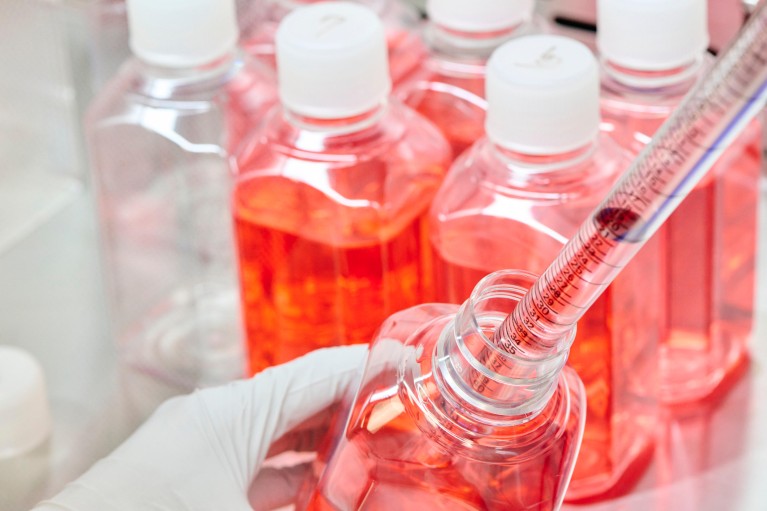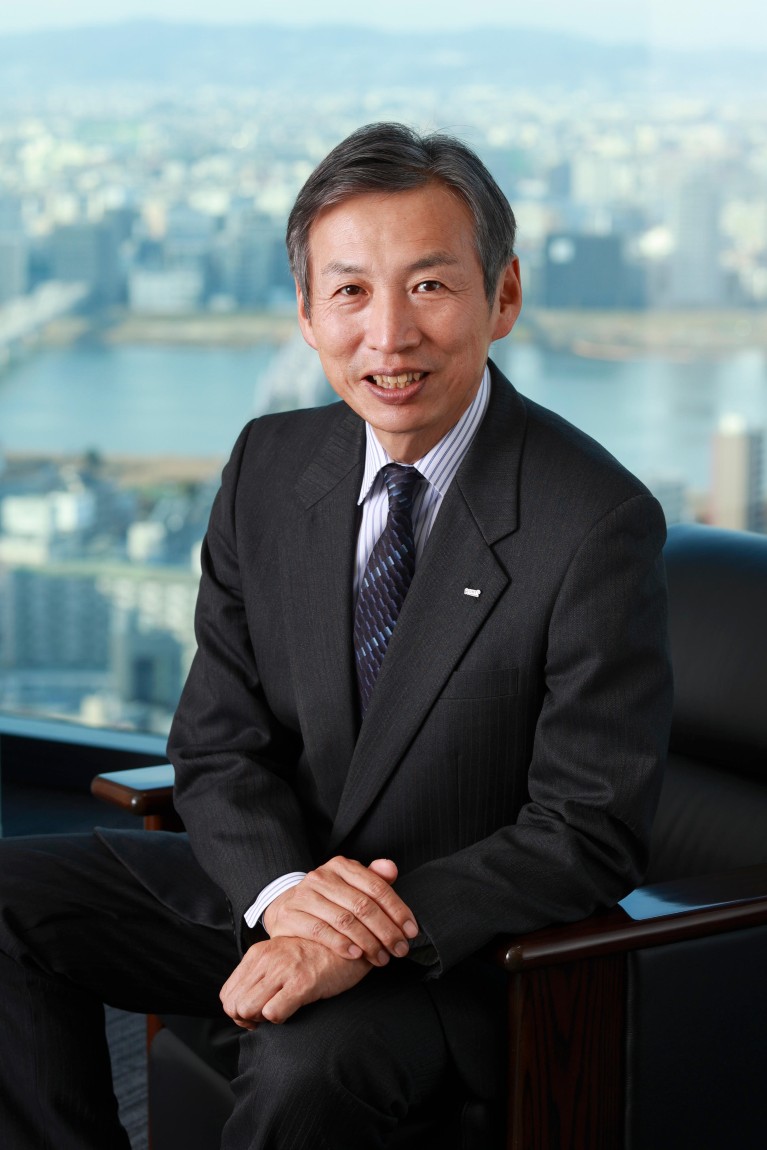
Bottles containing the cell-culturing medium developed by researchers at Rohto Pharmaceutical.© Rohto Pharmaceutical Co.,Ltd.
“We started producing eye drops at the beginning of the 20th century, and that was our main line for more than 100 years,” says Kunio Yamada, chief executive officer of Rohto Pharmaceutical, a multinational pharmaceutical company headquartered in Japan. But in an unexpected twist, the company added the development and manufacturing of stem-cell-therapy products to its portfolio, which gave them the idea of creating original cell-culture media.
“For more than a century, we’ve mainly focused on daily healthcare products and have accumulated a lot of knowledge and expertise in liquid handling and preparation, aseptic product manufacturing and formulation technologies,” says Yamada. “But with the advent of new cellular therapies, we wanted to try something new to extend our capabilities.”
In recent decades, the ability of stem cells to renew and generate multiple cell types has sparked great interest in their potential application in the field of regenerative medicine. But translating advanced cell-based therapies to the clinic has been extremely challenging.
“Cell products differ from general medicine because cells are alive, which makes it challenging to ensure a consistent quality,” explains Yamada. “Cultured cells are greatly affected by the culture method and medium quality.”
By using their in-house manufactured culture media, the company eventually hopes to develop safe and reliable new therapeutics based on stem-cell technologies.
Stem-cell treatments
Mesenchymal stromal cells (MSCs) are adult stem cells that can be sourced relatively easily from various body tissues including adipose (fat) tissue and the umbilical cord. MSCs can differentiate into many different cell types, such as bone, cartilage and fat cells.
“Adipose tissue can be harvested from adult donors with relatively low invasiveness. It’s usually harvested for treatment purposes and then discarded as medical waste,” says Yoichi Honma, head of regenerative medicine division at Rohto Pharmaceutical.
More than 55,000 studies have been published on MSC cell biology and their possible therapeutic applications. MSC therapies involve isolating and growing cells and manipulating them if required, which are then transplanted into the body to exert their therapeutic effects against target indications. MSCs may also support the repair and regeneration of injured tissue through differentiation and the trophic effect. A major advantage of using MSCs is their intrinsic ability to modulate inflammatory responses, reducing the risk of unwanted immune responses after administration.
“MSCs could potentially cure diseases that were previously considered incurable,” says Honma. “But their properties and mechanisms of action are still unclear, so it’s vital to further MSC research to deliver better treatments for patients.”

A scanning electron micrograph of a human mesenchymal stem cell (MSC). Using a consistent cell culture is critical for culturing MSCs for regenerative medicine research.© STEVE GSCHMEISSNER/SCIENCE PHOTO LIBRARY/Getty
Ongoing challenges
As of 2020, there were 11 globally approved MSC-based therapies for a range of diseases including graft-versus-host disease, Crohn’s disease and amyotrophic lateral sclerosis — and hundreds of ongoing clinical trials. While these initial successes are encouraging, the vast majority of MSC therapies have either not advanced beyond pre-clinical studies or failed in late-stage clinical trials.
Several factors have contributed to the limited success of clinical-stage MSC-based therapies — including huge variabilities in product potency. Primary human MSCs are inherently heterogeneous populations with characteristics that depend on the donor, tissue of origin, isolation method — and the reagents and protocols used to culture cells outside the body.
“Stem cells are very sensitive to the surrounding environment, and their properties vary greatly depending on the composition of the culture medium,” explains Honma. “It’s thus critical to employ a chemically-defined culture medium and minimize variations between batches to better control the characteristics of the MSCs.”
Cell-culture media contain a variety of ingredients, including carbohydrates, salts, pH buffers, amino acids, micronutrients, growth factors and hormones. They are formulated to support the growth of particular cell types. Many traditional recipes include fetal bovine serum, a nutrient-rich fluid derived from the blood of bovine fetuses, as a media additive.
“The composition of animal-derived components in fetal bovine serum is uncertain, and immunogenicity cannot be completely eliminated. In addition, batch-to-batch variability makes the cell culture unstable and hinders research,” says Honma. “Ingredients derived from animal and humans also pose the risk of transmission of viral diseases.”
Designer media
Rohto Pharmaceutical launched its first eye-drop product in 1909 and entered the skin-care market in 1975. “We’ve been studying stem cells as part of our skin-care business,” explains Yamada. “During that research, we’ve noticed that having a good culture method and medium is essential to achieve good efficacy in the human body.”

Kunio Yamada, Chief Executive Officer of Rohto Pharmaceutical.© Rohto Pharmaceutical Co.,Ltd.
This led the company’s researchers to create a new cell medium that is suitable for culturing primary human adipose and umbilical-cord-derived MSCs for clinical application. Importantly, it is free of animal and human-derived components tracing back to secondary raw materials.
“Being a chemically-defined, animal-origin free medium, it is possible to reduce batch-to-batch variability and the risk of immunogenicity and infectivity — contributing to a safer and more secure cell culture,” says Honma. “Another advantage is the high proliferative potential in primary culture, which has been an issue with conventional serum-free media.”
While good manufacturing practice standards are not needed for pre-clinical studies, using media and reagents that meet these requirements throughout the development pipeline will help facilitate the transition of lab research to the clinic.
“It’s important that the bridge from pre-clinical research to the clinic be seamless,” says Honma. “By carefully controlling everything from manufacturing facilities and the raw materials to manufacturing procedures and quality control, we can ensure that our culture media is suitable for clinical applications.”
Seizing opportunities
While MSC-based tissue engineering is a promising strategy for regenerative medicine, many challenges still need to be overcome to develop safe and effective new treatments for patients.
“Even though MSCs have been studied for more than three decades, several areas still remain to be fully elucidated, from basic to clinical applications,” says Honma.
Optimizing the protocols and reagents for culturing MSCs will help researchers to realize the full therapeutic potential of these unique cells.
“We expect the use of this culture media will help facilitate the transition from preclinical to clinical practice — and contribute to the revitalization of clinical research in the stem cell field,” concludes Honma. “We’ve started conducting clinical trials with MSCs cultured in our medium with the aim of developing regenerative-medicine products that will help us achieve our ultimate goal of improving human health and well-being.”



 Nature Index Japan 2023
Nature Index Japan 2023